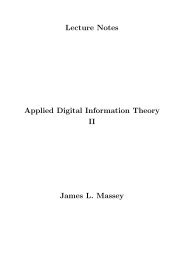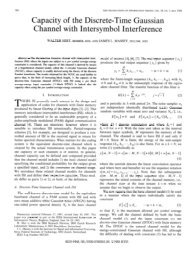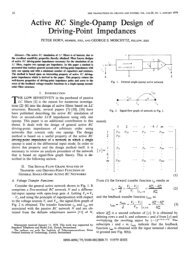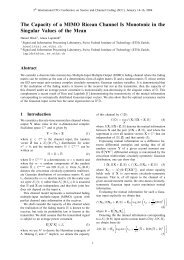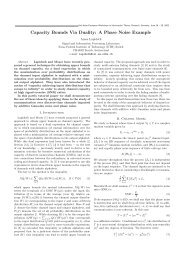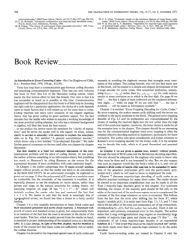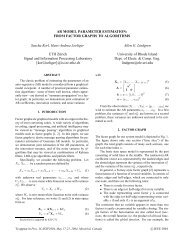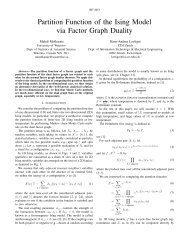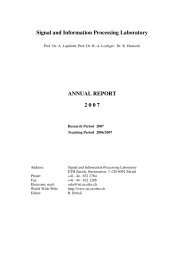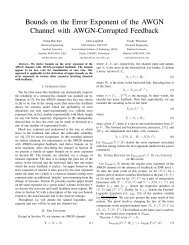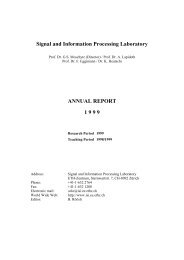Reverse Berlekamp-Massey Decoding
Reverse Berlekamp-Massey Decoding
Reverse Berlekamp-Massey Decoding
Create successful ePaper yourself
Turn your PDF publications into a flip-book with our unique Google optimized e-Paper software.
ISIT 2013<br />
<strong>Reverse</strong> <strong>Berlekamp</strong>-<strong>Massey</strong> <strong>Decoding</strong><br />
Jiun-Hung Yu and Hans-Andrea Loeliger<br />
Department of Information Technology and Electrical Engineering<br />
ETH Zurich, Switzerland<br />
Email: {yu, loeliger}@isi.ee.ethz.ch<br />
Abstract—We propose a new algorithm for decoding Reed-<br />
Solomon codes (up to half the minimum distance) and for computing<br />
inverses in F [x]/m(x). The proposed algorithm is similar<br />
in spirit and structure to the <strong>Berlekamp</strong>-<strong>Massey</strong> algorithm, but<br />
it works naturally for general m(x).<br />
I. INTRODUCTION<br />
In this paper, we propose a new algorithm that solves the<br />
following problem.<br />
Partial-Inverse Problem: Let b(x) and m(x) be nonzero<br />
polynomials over some finite field F , with deg b(x) <<br />
deg m(x). Find a nonzero polynomial Λ(x) ∈ F [x] of the<br />
smallest degree such that<br />
(<br />
)<br />
deg b(x)Λ(x) mod m(x) < d (1)<br />
for fixed d ∈ Z, 1 ≤ d ≤ deg m(x).<br />
In the special case where d = 1 and gcd ( b(x), m(x) ) = 1,<br />
the problem reduces to computing the inverse of b(x) in<br />
F [x]/m(x).<br />
Another special case of the Partial-Inverse Problem is the<br />
standard key equation for decoding Reed-Solomon codes [1]–<br />
[5] (see Section II-B). In this case, we have m(x) = x n−k ,<br />
where n and k are the blocklength and the dimension of the<br />
code, respectively. The proposed algorithm then essentially coincides<br />
with the <strong>Berlekamp</strong>-<strong>Massey</strong> algorithm [2], [6] except<br />
that it processes the polynomial b(x) (the syndrome) in the<br />
reverse order.<br />
The Partial-Inverse Problem with general m(x) arises from<br />
an alternative key equation that will be discussed in Section<br />
IV. This alternative key equation and the corresponding<br />
decoding algorithm generalize naturally to polynomial remainder<br />
codes [7], [9]–[11], which have not been amenable to<br />
<strong>Berlekamp</strong>-<strong>Massey</strong> decoding.<br />
The Partial-Inverse Problem can also be solved by a version<br />
of the Euclidean algorithm in the style of [3], [5], [7], [8].<br />
In fact, it has long been known that the <strong>Berlekamp</strong>-<strong>Massey</strong><br />
algorithm and the Euclidean algorithm are related [12]–[14],<br />
and explicit translations were given in [12], [14]. In this<br />
respect, the algorithm proposed in this paper allows such a<br />
translation that is particularly transparent. However, this topic<br />
is not elaborated in the present paper due to lack of space.<br />
The paper is structured as follows. Section II comprises a<br />
number of remarks on the Partial-Inverse Problem, including<br />
its application to the standard key equation. The new algorithm<br />
is proposed in Section III and proved in Sections V and VI.<br />
✷<br />
<strong>Decoding</strong> Reed-Solomon codes via the alternative key equation<br />
is described in Section IV, and the generalization of this<br />
approach to polynomial remainder codes is outlined in the<br />
appendix.<br />
The following notation will be used. The Hamming weight<br />
of e ∈ F n will be denoted by w H (e). The coefficient of<br />
x l of a polynomial b(x) ∈ F [x] will be denoted b l . The<br />
leading coefficient (i.e., the coefficient of x deg b(x) ) of a<br />
nonzero polynomial b(x) will be denoted by lcf b(x), and<br />
we also define lcf(0) = △ 0. We will use “mod” both as in<br />
r(x) = b(x) mod m(x) (the remainder of a division) and as<br />
in b(x) ≡ r(x) mod m(x) (a congruence modulo m(x)). For<br />
x ∈ R, ⌈x⌉ is the smallest integer not smaller than x.<br />
A. General Remarks<br />
II. REMARKS<br />
We begin with a number of remarks on the Partial-Inverse<br />
Problem as stated in Section I.<br />
1) The stated assumptions imply deg m(x) ≥ 1.<br />
2) For d = deg m(x), the problem is solved by Λ(x) = 1.<br />
Smaller values of d will normally require a polynomial<br />
Λ(x) of higher degree.<br />
3) In the special case where d = 1, we have the following<br />
solutions. If gcd ( b(x), m(x) ) = 1, then b(x) has an<br />
inverse in F [x]/m(x) and Λ(x) is that inverse (up<br />
to a scale factor); otherwise, the solution is Λ(x) =<br />
m(x)/ gcd ( b(x), m(x) ) , which yields b(x)Λ(x) mod<br />
m(x) = 0.<br />
4) The previous remark implies that the problem has a<br />
solution for any d ≥ 1.<br />
5) We will see that the solution Λ(x) of the problem is<br />
unique up to a scale factor (Proposition 2 in Section V)<br />
and satisfies<br />
deg Λ(x) ≤ deg m(x) − d (2)<br />
(by (42) in Section VI).<br />
6) In consequence of (2), coefficients b l of b(x) with<br />
and coefficients m l of m(x) with<br />
l < 2d − deg m(x) (3)<br />
l < 2d − deg m(x) + 1 (4)<br />
are irrelevant for the solution Λ(x): these coefficients do<br />
not affect (1) since<br />
b(x)Λ(x) mod m(x) = b(x)Λ(x) − q(x)m(x) (5)
with deg q(x) < deg Λ(x) ≤ deg m(x) − d.<br />
Such irrelevant coefficients may be set to zero without<br />
affecting the solution Λ(x).<br />
B. Application to the Standard Key Equation<br />
The standard key equation for decoding Reed-Solomon<br />
codes [2]–[5], [13] is<br />
S(x)Λ(x) ≡ Γ(x) mod x n−k , (6)<br />
where n and k are the blocklength and the dimension of<br />
the code, respectively, and where S(x) is a (given) syndrome<br />
polynomial with deg S(x) < n − k. The desired solution is<br />
a pair Γ(x) and Λ(x) ≠ 0 such that deg Γ(x) < deg Λ(x) ≤<br />
(n − k)/2.<br />
The problem of finding such a pair Γ(x) and Λ(x)<br />
translates into a Partial-Inverse Problem with b(x) = S(x),<br />
m(x) = x n−k , and d = ⌈(n − k)/2⌉. Because of (2), the<br />
resulting Λ(x) satisfies deg Λ(x) ≤ (n − k)/2, and we have<br />
Γ(x) = S(x)Λ(x) mod x n−k . If the number of errors does<br />
not exceed (n − k)/2, the condition deg Γ(x) < deg Λ(x)<br />
will then be satisfied automatically.<br />
III. THE ALGORITHM<br />
The Partial-Inverse Problem as stated in Section I can be<br />
solved by the following algorithm.<br />
Proposed Algorithm:<br />
Input: b(x), m(x), and d as in the problem statement.<br />
Output: Λ(x) as in the problem statement.<br />
1 if deg b(x) < d begin<br />
2 return Λ(x) := 1<br />
3 end<br />
4 Λ (1) (x) := 0, d 1 := deg m(x), κ 1 := lcf m(x)<br />
5 Λ (2) (x) := 1, d 2 := deg b(x), κ 2 := lcf b(x)<br />
6 loop begin<br />
7 Λ (1) (x) := κ 2 Λ (1) (x) − κ 1 x d1−d2 Λ (2) (x)<br />
8 d 1 := deg ( b(x)Λ (1) (x) mod m(x) )<br />
9 if d 1 < d begin<br />
10 return Λ(x) := Λ (1) (x)<br />
11 end<br />
12 κ 1 := lcf ( b(x)Λ (1) (x) mod m(x) )<br />
13 if d 1 < d 2 begin<br />
14 (Λ (1) (x), Λ (2) (x)) := (Λ (2) (x), Λ (1) (x))<br />
15 (d 1 , d 2 ) := (d 2 , d 1 )<br />
16 (κ 1 , κ 2 ) := (κ 2 , κ 1 )<br />
17 end<br />
18 end ✷<br />
Note that lines 14–16 simply swap Λ (1) (x) with Λ (2) (x),<br />
d 1 with d 2 , and κ 1 with κ 2 . The only actual computations are<br />
in lines 7 and 8.<br />
The correctness of this algorithm will be proved in Section<br />
VI. In particular, we will see that the value of d 1 is<br />
reduced in every execution of line 8.<br />
Note that lines 8 and 12 do not require the computation of<br />
the entire polynomial b(x)Λ (1) (x) mod m(x). Indeed, lines 8–<br />
12 can be replaced by the following loop:<br />
Equivalent Alternative to Lines 8–12:<br />
31 repeat<br />
32 d 1 := d 1 − 1<br />
33 if d 1 < d begin<br />
34 return Λ(x) := Λ (1) (x)<br />
35 end<br />
36 κ 1 := coefficient of x d1 in<br />
b(x)Λ (1) (x) mod m(x)<br />
37 until κ 1 ≠ 0<br />
In the special case where m(x) = x ν , line 36 amounts to<br />
41 κ 1 := b d1 Λ (1)<br />
0 + b d1−1Λ (1)<br />
1 + . . . + b d1−τ Λ (1)<br />
τ<br />
with τ = △ deg Λ (1) △<br />
(x) and where b l = 0 for l < 0. In the other<br />
special case where m(x) = x n − 1 as in (10) below, line 36<br />
becomes<br />
51 κ 1 := b d1 Λ (1)<br />
0 + b [d1−1]Λ (1)<br />
1 + . . . + b [d1−τ]Λ (1)<br />
τ<br />
△<br />
with b [l] = b l mod n . In both cases, the proposed algorithm<br />
looks very much like, and is as efficient as, the <strong>Berlekamp</strong>-<br />
<strong>Massey</strong> algorithm [6].<br />
IV. DECODING REED-SOLOMON CODES VIA AN<br />
ALTERNATIVE KEY EQUATION<br />
<strong>Decoding</strong> Reed-Solomon codes (up to half the minimum<br />
distance) can be reduced rather directly to the Partial-Inverse<br />
Problem of Section I as follows.<br />
Let F be a finite field, let β 0 , . . . , β n−1 be n different<br />
elements of F , let m(x) = ∏ △ n−1<br />
l=0 (x − β l), let F [x]/m(x)<br />
be the ring of polynomials modulo m(x), and let ψ be the<br />
evaluation mapping<br />
ψ : F [x]/m(x) → F n : a(x) ↦→ ( a(β 0 ), . . . , a(β n−1 ) ) , (7)<br />
which is a ring isomorphism. A Reed-Solomon code with<br />
blocklength n and dimension k may be defined as<br />
{c = (c 0 , . . . , c n ) ∈ F n : deg ψ −1 (c) < k}, (8)<br />
usually with the additional condition that<br />
β l = α l for l = 0, . . . , n − 1, (9)<br />
where α ∈ F is a primitive n-th root of unity. The condition<br />
(9) implies<br />
m(x) = x n − 1 (10)<br />
and turns ψ into a discrete Fourier transform [4]. However,<br />
(9) and (10) will not be required below.<br />
Let y = (y 0 , . . . , y n−1 ) ∈ F n be the received word, which<br />
we wish to decompose into<br />
y = c + e (11)<br />
where c ∈ C is a codeword and where the Hamming weight<br />
of e = (e 0 , . . . , e n−1 ) ∈ F n is as small as possible.
Let C(x) = △ ψ −1 (c), and analogously E(x) = △ ψ −1 (e)<br />
and Y (x) = △ ψ −1 (y). Clearly, we have deg C(x) < k and<br />
deg E(x) < deg m(x) = n.<br />
For any e ∈ F n , we define the error locator polynomial<br />
∏<br />
Λ e (x) =<br />
△ (x − β l ). (12)<br />
l ∈ {0, . . . , n − 1}<br />
e l ≠ 0<br />
Clearly, deg Λ e (x) = w H (e) and<br />
E(x)Λ e (x) mod m(x) = 0. (13)<br />
Theorem 1 (Alternative Key Equation). If w H (e) ≤ n−k<br />
2 ,<br />
then the error locator polynomial Λ e (x) satisfies<br />
deg ( Y (x)Λ e (x) mod m(x) ) < n − n − k (14)<br />
2<br />
Conversely, for any y and e ∈ F n and t ∈ R with<br />
w H (e) ≤ t ≤ n − k , (15)<br />
2<br />
if some nonzero Λ(x) ∈ F [x] with deg Λ(x) ≤ t satisfies<br />
(<br />
)<br />
deg Y (x)Λ(x) mod m(x) < n − t, (16)<br />
then Λ(x) is a multiple of Λ e (x).<br />
The proof is not difficult, but omitted due to lack of space.<br />
We thus arrive at the following decoding procedure:<br />
1) Compute Y (x) = ψ −1 (y).<br />
2) Run the algorithm of Section III with b(x) = Y (x) and<br />
d = ⌈ n+k<br />
2 ⌉. If w H(e) ≤ n−k<br />
2<br />
, then the polynomial Λ(x)<br />
returned by the algorithm equals Λ e (x) up to a scale<br />
factor.<br />
3) Complete decoding by any standard method [4] or by<br />
means of Proposition 1 below.<br />
Note that in Step 2, because of (3), coefficients Y l of Y (x)<br />
with<br />
{<br />
△ k, if n − k is even<br />
l < l min =<br />
(17)<br />
k + 1, if n − k is odd<br />
are irrelevant for finding Λ(x) and can be set to zero. The<br />
remaining coefficients Y l are syndromes since C l = 0 and<br />
Y l = E l for l ≥ l min .<br />
As mentioned, decoding can be completed by the following<br />
proposition:<br />
Proposition 1. If Λ(x) is a nonzero multiple of Λ e (x) with<br />
deg Λ(x) ≤ n − k, then<br />
C(x) =<br />
Y (x)Λ(x) mod m(x)<br />
Λ(x)<br />
Proof: If Λ(x) has the stated properties, then<br />
Y (x)Λ(x) mod m(x)<br />
✷<br />
(18)<br />
✷<br />
= C(x)Λ(x) mod m(x) + E(x)Λ(x) mod m(x) (19)<br />
= C(x)Λ(x), (20)<br />
where the second term in (19) vanishes because of (13).<br />
Note that computing the numerator of (18) may be viewed<br />
as continuing the algorithm of Section III (line 36) with frozen<br />
Λ (1) (x) = Λ(x).<br />
✷<br />
V. KEY ELEMENTS OF THE PROOF<br />
We now turn to the proof of the algorithm proposed in<br />
Section III. In this section, we discuss some key elements of<br />
the proof; the actual proof will then be given in Section VI.<br />
The pivotal part of the algorithm is line 7, which is<br />
explained by the following simple lemma. (The corresponding<br />
statement for the <strong>Berlekamp</strong>-<strong>Massey</strong> algorithm is the twowrongs-make-a-right<br />
lemma, so called by J. L. <strong>Massey</strong>.)<br />
Lemma 1. Let m(x) be a polynomial over F with deg m(x) ≥<br />
1. For further polynomials b(x), Λ (1) (x), Λ (2) (x) ∈ F [x], let<br />
r (1) (x) △ = b(x)Λ (1) (x) mod m(x), (21)<br />
r (2) (x) △ = b(x)Λ (2) (x) mod m(x), (22)<br />
△<br />
d 1 = deg r (1) △<br />
(x), κ 1 = lcf r (1) △<br />
(x), d 2 = deg r (2) △<br />
(x), κ 2 =<br />
lcf r (2) (x), and assume d 1 ≥ d 2 ≥ 0. Then<br />
satisfies<br />
Λ(x) △ = κ 2 Λ (1) (x) − κ 1 x d1−d2 Λ (2) (x) (23)<br />
(<br />
)<br />
deg b(x)Λ(x) mod m(x) < d 1 . (24)<br />
✷<br />
Proof: From (23), we obtain<br />
r(x) △ = b(x)Λ(x) mod m(x) (25)<br />
= κ 2 r (1) (x) − κ 1 x d1−d2 r (2) (x) (26)<br />
by the natural ring homomorphism F [x] → F [x]/m(x). It is<br />
then obvious from (26) that deg r(x) < deg r (1) (x) = d 1 . ✷<br />
A similar argument proves<br />
Proposition 2 (Uniqueness of Solution). The solution Λ(x)<br />
of the Partial-Inverse Problem of Section I is unique up to a<br />
scale factor.<br />
✷<br />
Proof: Let Λ (1) (x) and Λ (2) (x) be two solutions of the<br />
problem, which implies deg Λ (1) (x) = deg Λ (2) (x) ≥ 0.<br />
Define r (1) (x) and r (2) (x) as in (21) and (22) and consider<br />
( ) ( )<br />
Λ(x) =<br />
△ lcf Λ (2) (x) Λ (1) (x) − lcf Λ (1) (x) Λ (2) (x). (27)<br />
Then<br />
r(x) = △ b(x)Λ(x) mod m(x) (28)<br />
( ) ( )<br />
= lcf Λ (2) (x) r (1) (x) − lcf Λ (1) (x) r (2) (x), (29)<br />
which implies that Λ(x) also satisfies (1). But (27) implies<br />
deg Λ(x) < deg Λ (1) (x), which is a contradiction unless<br />
Λ(x) = 0. Thus Λ(x) = 0, which means that Λ (1) (x) and<br />
Λ (2) (x) are equal up to a scale factor.<br />
✷<br />
Definition (Minimal Partial Inverse): For fixed nonzero<br />
b(x) and m(x) ∈ F [x] with deg b(x) < deg m(x), a nonzero<br />
polynomial Λ(x) ∈ F [x] is a minimal partial inverse of b(x)<br />
if (<br />
) (<br />
)<br />
deg b(x)Λ (1) (x) mod m(x) ≤ deg b(x)Λ(x) mod m(x)<br />
(30)<br />
(with Λ (1) (x) ≠ 0) implies deg Λ (1) (x) ≥ deg Λ(x). ✷
The following lemma is the counterpart to Theorem 1 of [6].<br />
Lemma 2 (Degree Change Lemma). For fixed nonzero b(x)<br />
and m(x) ∈ F [x] with deg b(x) < deg m(x), let Λ(x) be a<br />
minimal partial inverse of b(x) and let<br />
If<br />
r(x) △ = b(x)Λ(x) mod m(x). (31)<br />
deg Λ(x) ≤ deg m(x) − deg r(x), (32)<br />
then any nonzero polynomial Λ (1) (x) ∈ F [x] such that<br />
satisfies<br />
deg ( b(x)Λ (1) (x) mod m(x) ) < deg r(x) (33)<br />
deg Λ (1) (x) ≥ deg m(x) − deg r(x). (34)<br />
✷<br />
The proof is given below.<br />
Corollary: Assume everything as in Lemma 2 including (32)<br />
and (33). If (34) is satisfied with equality, then Λ (1) (x) is also<br />
a minimal partial inverse of b(x).<br />
Proof of Lemma 2: Assume that Λ (1) (x) is a nonzero<br />
polynomial that satisfies (33), i.e., the degree of<br />
satisfies<br />
r (1) (x) △ = b(x)Λ (1) (x) mod m(x) (35)<br />
deg r (1) (x) < deg r(x). (36)<br />
Multiplying (31) by Λ (1) (x) and (35) by Λ(x) yields<br />
Λ (1) (x)r(x) ≡ Λ(x)r (1) (x) mod m(x). (37)<br />
If we assume both (32) and (contrary to (34))<br />
then (37) reduces to<br />
deg Λ (1) (x) < deg m(x) − deg r(x), (38)<br />
Λ (1) (x)r(x) = Λ(x)r (1) (x). (39)<br />
But then (36) implies deg Λ (1) (x) < deg Λ(x), which is<br />
impossible because Λ(x) is a minimal partial inverse. Thus<br />
(32) and (38) cannot hold simultaneously. ✷<br />
VI. PROOF OF THE PROPOSED ALGORITHM<br />
We now prove the correctness of the algorithm proposed in<br />
Section III. To this end, we restate the algorithm with added<br />
assertions as follows.<br />
Proposed Algorithm Restated:<br />
1 if deg b(x) < d begin<br />
2 return Λ(x) := 1<br />
3 end<br />
4 Λ (1) (x) := 0, d 1 := deg m(x), κ 1 := lcf m(x)<br />
5 Λ (2) (x) := 1, d 2 := deg b(x), κ 2 := lcf b(x)<br />
6 loop begin<br />
Assertions:<br />
d 1 > d 2 ≥ d<br />
(A.1)<br />
deg Λ (2) (x) = deg m(x) − d 1 (A.2)<br />
> deg Λ (1) (x) (A.3)<br />
Λ (2) (x) is a minimal partial inverse (A.4)<br />
7 repeat<br />
8 Λ (1) (x) := κ 2 Λ (1) (x) − κ 1 x d1−d2 Λ (2) (x)<br />
Assertions:<br />
deg(b(x)Λ (1) (x) mod m(x)) < d 1 (A.5)<br />
deg Λ (1) (x) = deg m(x) − d 2 (A.6)<br />
> deg Λ (2) (x) (A.7)<br />
9 d 1 := deg ( b(x)Λ (1) (x) mod m(x) )<br />
10 if d 1 < d begin<br />
Assertion:<br />
Λ (1) (x) is a min. partial inverse (A.8)<br />
11 return Λ(x) := Λ (1) (x)<br />
12 end<br />
13 κ 1 := lcf ( b(x)Λ (1) (x) mod m(x) )<br />
14 until d 1 < d 2<br />
Assertion:<br />
Λ (1) (x) is a minimal partial inverse<br />
15 (Λ (1) (x), Λ (2) (x)) := (Λ (2) (x), Λ (1) (x))<br />
16 (d 1 , d 2 ) := (d 2 , d 1 )<br />
17 (κ 1 , κ 2 ) := (κ 2 , κ 1 )<br />
18 end<br />
(A.9)<br />
Note the added inner repeat loop (lines 7–14), which does<br />
not change the algorithm but helps to state its proof.<br />
Throughout the algorithm (except at the very beginning,<br />
before the first execution of lines 9 and 13), d 1 , d 2 , κ 1 ,<br />
and κ 2 are defined as in Lemma 1, i.e., d 1 = deg r (1) (x),<br />
κ 1 = lcf r (1) (x), d 2 = deg r (2) (x), and κ 2 = lcf r (2) (x) for<br />
r (1) (x) and r (2) (x) as in (21) and (22).<br />
Assertions (A.1)–(A.4) are easily verified, both from the<br />
initialization and from (A.6), (A.7), and (A.9).<br />
As for (A.5), after the very first execution of line 8, we<br />
still have d 1 = deg m(x) (from line 4), which makes (A.5)<br />
obvious. For all later executions of line 8, (A.5) follows from<br />
Lemma 1.<br />
As for (A.6) and (A.7), we note that line 8 changes the<br />
degree of Λ (1) (x) as follows:<br />
• Upon entering the repeat loop, line 8 increases the degree<br />
of Λ (1) to<br />
deg Λ (2) (x) + d 1 − d 2 = deg m(x) − d 2 (40)<br />
> deg Λ (2) (x), (41)<br />
which follows from (A.1)–(A.3).<br />
• Subsequent executions of line 8 without leaving the<br />
repeat loop (i.e., without executing lines 15–17) do not<br />
change the degree of Λ (1) (x). (This follows from the fact<br />
that d 1 is smaller than in the first execution while Λ (2) (x),<br />
d 2 , and κ 2 ≠ 0 remain unchanged.)
Assertion (A.9) follows from the Corollary to Lemma 2<br />
(with Λ(x) = Λ (2) (x) and deg r(x) = d 2 ), which applies<br />
because d 1 < d 2 and (A.6). Because of (A.1), the same<br />
argument applies also to (A.8).<br />
Finally, (A.1) and (A.6) imply that the polynomial Λ(x)<br />
returned by the algorithm satisfies<br />
deg Λ(x) ≤ deg m(x) − d. (42)<br />
VII. CONCLUSION<br />
We have proposed a new algorithm for decoding Reed-<br />
Solomon codes and polynomial remainder codes, and for<br />
computing inverses in F [x]/m(x). In the special case where<br />
m(x) = x ν or m(x) = x n − 1, the proposed algorithm almost<br />
coincides with the <strong>Berlekamp</strong>-<strong>Massey</strong> algorithm, except that<br />
it processes the syndrome in reverse order.<br />
APPENDIX: EXTENSION TO POLYNOMIAL<br />
REMAINDER CODES<br />
Polynomial remainder codes [7], [9]–[11] are a class of<br />
codes that include Reed-Solomon codes as a special case. We<br />
briefly outline how decoding via the alternative key equation of<br />
Section IV generalizes to polynomial remainder codes, which<br />
can thus be decoded by the algorithm of Section III.<br />
Let m 0 (x), . . . , m n−1 (x) ∈ F [x] be relatively prime and let<br />
m(x) = ∏ △ n−1<br />
l=0 m △<br />
l(x). Let R m = F [x]/m(x) denote the ring<br />
△<br />
of polynomials modulo m(x) and let R ml = F [x]/m l (x).<br />
The mapping (7) is generalized to the ring isomorphism<br />
ψ : R m → R m0 × . . . × R mn−1 :<br />
a(x) ↦→ ψ(a) △ = ( ψ 0 (a), . . . , ψ n−1 (a) ) (43)<br />
with ψ l (a) △ = a(x) mod m l (x). Following [11], a polynomial<br />
remainder code may be defined as<br />
{c = (c 0 , . . . , c n−1 ) ∈ R m0 ×. . .×R mn−1 : deg ψ −1 (c) < K}<br />
(44)<br />
where<br />
k−1<br />
∑<br />
K =<br />
△ deg m l (x) (45)<br />
l=0<br />
for some fixed k, 0 < k < n. We also define<br />
n−1<br />
∑<br />
N = △ deg m(x) = deg m l (x). (46)<br />
l=0<br />
As in Section IV, let y = c + e be the received word with<br />
c ∈ C, and let C(x) = △ ψ −1 (c), E(x) = △ ψ −1 (e), and Y (x) =<br />
△<br />
ψ −1 (y). Clearly, deg C(x) < K and deg E(x) < N.<br />
For such codes, the error locator polynomial<br />
∏<br />
Λ e (x) =<br />
△ m l (x) (47)<br />
l ∈ {0, . . . , n − 1}<br />
e l ≠ 0<br />
and the error factor polynomial [11]<br />
Λ f (x) △ = m(x)/ gcd ( E(x), m(x) ) (48)<br />
do not, in general, coincide. However, if all moduli m l (x) are<br />
irreducible, then Λ f (x) = Λ e (x).<br />
We then have the following generalization of Theorem 1:<br />
Theorem 2. For given y and e with deg Λ f (x) ≤ t ≤ N−K<br />
2<br />
,<br />
assume that some nonzero polynomial Λ(x) with deg Λ(x) ≤ t<br />
satisfies<br />
deg ( Y (x)Λ(x) mod m(x) ) < N − t. (49)<br />
Then Λ(x) is a multiple of Λ f (x). Conversely, Λ(x) = Λ f (x)<br />
is a polynomial of the smallest degree that satisfies (49). ✷<br />
It follows that the decoding procedure of Section IV works<br />
also for polynomial remainder codes, except that n, k, and<br />
Λ e (x) are replaced by N, K, and Λ f (x), respectively. Moreover,<br />
C(x) can still be recovered from Λ(x) by means of (18)<br />
[11].<br />
REFERENCES<br />
[1] I. S. Reed and G. Solomon, “Polynominal codes over certain finite<br />
fields,” J. SIAM, vol. 8, pp. 300–304, Oct. 1962.<br />
[2] E. R. <strong>Berlekamp</strong>, “Algebraic Coding Theory.” New York: McGraw-Hill,<br />
1968.<br />
[3] Y. Sugiyama, M. Kasahara, S. Hirasawa, and T. Namekawa, “A method<br />
for solving key equation for decoding Goppa codes,” Information and<br />
Control, vol. 27, pp. 87–99, 1975.<br />
[4] R. E. Blahut, “Algebraic Codes for Data Transmission.” Cambridge<br />
University Press, Cambridge, UK, 2003.<br />
[5] R. M. Roth, Introduction to Coding Theory. New York: Cambridge<br />
University Press, 2006.<br />
[6] J. L. <strong>Massey</strong>, “Shift-register synthesis and BCH decoding,” IEEE Trans.<br />
Information Theory, vol. 15, pp. 122-127, May 1969.<br />
[7] A. Shiozaki, “<strong>Decoding</strong> of redundant residue polynomial codes using<br />
Euclid’s algorithm,” IEEE Trans. Information Theory, vol. 34, pp. 1351–<br />
1354, Sep. 1988.<br />
[8] S. Gao, “A new algorithm for decoding Reed-Solomon codes,” in<br />
Communications, Information and Network Security, V. Bhargava, H.<br />
V. Poor, V. Tarokh, and S.Yoon, Eds. Norwell, MA: Kluwer, 2003, vol.<br />
712, pp. 55-68.<br />
[9] J. J. Stone, “Multiple-burst error correction with the Chinese Remainder<br />
Theorem,” J. SIAM, vol. 11, pp. 74–81, Mar. 1963.<br />
[10] J.-H. Yu and H.-A. Loeliger, “On irreducible polynomial remainder<br />
codes,” IEEE Int. Symp. on Information Theory, Saint Petersburg,<br />
Russia, July 31–Aug. 5, 2011.<br />
[11] J.-H. Yu and H.-A. Loeliger, “On polynomial remainder codes,”<br />
http://arxiv.org/abs/1201.1812.<br />
[12] J. L. Dornstetter, “On the equivalence between <strong>Berlekamp</strong>s’s and Euclids’s<br />
algorithms,” IEEE Trans. Information Theory, vol. 33, pp. 428-<br />
431, May 1987.<br />
[13] P. Fitzpatrick, “On the key equation,” IEEE Trans. Information Theory,<br />
vol. 41, pp. 1290-1302, Sep. 1995.<br />
[14] A. E. Heydtmann and J. M. Jensen, “On the equivalence of the<br />
<strong>Berlekamp</strong>-<strong>Massey</strong> and Euclidean algorithms for decoding,” IEEE<br />
Trans. Information Theory, vol. 46, pp. 2614-2624, Nov. 2000.



